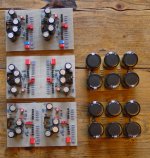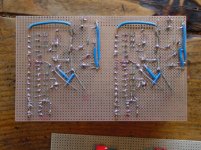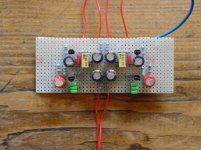Symmetry is a good thing in hifi and in order to get the two (or more) channels identical (more or less). My thing is to make the channels as two duplicates, not mirrored (much work). It's just to press CTRL-D (but I press CMD-D since i use Macintosh) and move the duplicated piece. If I make a design with mixed parts, matched transistors, regulators, IC's it's virtually impossible to make the PCB 2 x the design. Connectors, skrewholes makes a small asymmetry if you have limitations of the board size.
In the pearls i made some changes, as you may see there are more toshibas to make the pearl fit for low output MCs and i tried to make them as small as possible, the circuits are 2x3 inches for one channel and i cant make them smaller. There was no reason using the 2sk389 as i use for jfet in the output for minimum. The output coppling capacitor is a black gate bn unpolarized cap, they sound amazing, unbelievebal for a electrolytical capacitor.
I matchet 100 jfets for the pearls.
I soldered 96 transistors 78 capacitors and maybe 200 resistors just to test my patience.
As you see, i put in some dip switches to make it possible, to find the right resistance for every MC between 30 ohm and 2K, that should work for every low output MC.
All the voltages are allmost perfekt, the matching still had some tolerance, below 5 percent in the worst case but i think that will be no problem. I didnt want to buy more of them.
I matchet 100 jfets for the pearls.
I soldered 96 transistors 78 capacitors and maybe 200 resistors just to test my patience.
As you see, i put in some dip switches to make it possible, to find the right resistance for every MC between 30 ohm and 2K, that should work for every low output MC.
All the voltages are allmost perfekt, the matching still had some tolerance, below 5 percent in the worst case but i think that will be no problem. I didnt want to buy more of them.
beautiful job!
Tell us more about the sound of these beautiful looking phono preamps. I'm just now rediscovering vinyl audio and will, eventually, construct the pearls. Your efforts are an inspiration to me.
And while I'm gushing: Nelson is such a treasure to our DIY community. What would we do without him?
John Inlow
Tell us more about the sound of these beautiful looking phono preamps. I'm just now rediscovering vinyl audio and will, eventually, construct the pearls. Your efforts are an inspiration to me.
And while I'm gushing: Nelson is such a treasure to our DIY community. What would we do without him?
John Inlow
Thanks Wayne
I saw your name (Wayne Colburn) at the head of the Pearls article and thought you were the author of that article. Since you're also the designer, it seems most appropriate to thank you and give credit where credit is due.
Thanks Wayne,
John Inlow
I saw your name (Wayne Colburn) at the head of the Pearls article and thought you were the author of that article. Since you're also the designer, it seems most appropriate to thank you and give credit where credit is due.
Thanks Wayne,
John Inlow
Hi Oliver, some questions as i'm ordering parts for the pearl at the moment.
What did you use instead of the sk389, paralleled sk170? Did you buy the jfets from "Schuro"? Do you think that a BlackGate sounds better than a film-cap?
arndt
p.s.: Any experience yet from the DAC-Filter? What DAC-Chip is connected?
What did you use instead of the sk389, paralleled sk170? Did you buy the jfets from "Schuro"? Do you think that a BlackGate sounds better than a film-cap?
arndt
p.s.: Any experience yet from the DAC-Filter? What DAC-Chip is connected?
Joe, yes i matched and paralled sk170 from schuro, they made a good price for 100 peaces.
The black gates N sound better than all film caps i know, exept Jensen paper in oil and maybe Mundorf zncap, they sound extrem clean and smoth with deep space (after two weeks), no harshness no highfequency feepsing and no resonances.
The black gates N sound better than all film caps i know, exept Jensen paper in oil and maybe Mundorf zncap, they sound extrem clean and smoth with deep space (after two weeks), no harshness no highfequency feepsing and no resonances.
Carpenter, i have one pearl working for 4 month now, i used naim phonoboards before with a better power source than the original and i must say the pearls beat then in allmost every manner, they are much cleaner, grain free like alephs, quiet between the notes and very liquit in the way of rythms and notes floating out of the speakers. Compared to my cd player ( fully modified rotel with xo clock, most capacitors changed and a single ended output stage with passive filter ) the advantages from the pearl over cd is the liquidity, better colours and finer textures.
Joe the dac filter is for pcm 63 dacs, i will try them when the pearls are in their cases and on the way to their owners. I have my own converter with a passive filter which sounds very nice, lightyears from burr brown, analog devices and other opamps i tried before. Especially in high frequencies and voices Integrated opamps sound really bad. Its really a bad joke when i see cd players for 8000 euro that still use this opamps that sound like a drain. The interesting thing for me was that i use only one stage for converting and for gain and the passlabs converter uses this cascading mosfet for conversion and i want to now what sonical difference it makes. The other point was that i wanted to put it inside the cd player case and use its own +/- 15 volt for the analog stage instad of the power source i made for my converter. If it doesnt sound perfekt i will make another converter with irf610 and +/- 30 volt.
A lot of people say that the Pearls are better then Naim. Is this true?
I know that Naim in general has to complicated circuits for my taste.
I know that Naim in general has to complicated circuits for my taste.
Prometheus, i used the naim for several years and the pearl does everything better, they have less noise, less distortion and grain (like alephs), the bass is better and the stage deeper. The first thing you mention switching from naim too pearl is that there is quietness between the notes and a kind of liquidity in the timing. The pearls sound beautiful compared to the naims, they are really pearls.
Hallo Oliver,
I am back with a question about the analog output circuit you made.
I need an analog circuit like Nelson Pass uses but I am using the PCM1704 which has a single ended output. How could I use the nelson pass circuit with single ended input , balanced output and no volume but at specific gain ?
I am back with a question about the analog output circuit you made.
I need an analog circuit like Nelson Pass uses but I am using the PCM1704 which has a single ended output. How could I use the nelson pass circuit with single ended input , balanced output and no volume but at specific gain ?
Promitheus, the circuit doesn´t convert unbalanced into balanced signal that why the original passlabs circuit uses two dac´s to give the analog stage an balanced signal on the input. The circuit works happily without attentuator and you can plug it into any preamp input if you like, the gain is somewhere around 12 or 14 DB for the unbalanced version and i guess 6 db more in balanced mode. You can reduce the gain a little bit reducing R32 and R33 but just a little because the circuit will turn off if you go to low. If you need a unbalanced balanced conversion every balanced pass preamp will do the the job.
For the pearl ps wayne used a irf9610, can i used irf9620 without any problems? what are the critical passives of the RIAA? can i used polycarbonates for the values can't source polyprop? thanks
Of course you can use the 9620 it will not make any problems.
In the RIAA stage allmost every part is critical because every changing has an influence on the frequency response. You should use 1% resistors for the network. I have used Wima MKS for the network and they work fine. But its recommended to match them to 2% tolerance if possible, because the RIAA is quite sensible to changings. Its difficult to get cappacitors which have a nominal tolerance of 2% so you should by a bigger quantity and match them with an RCA voltmeter. The wima have the lowest price at www.schuro.de The type of cappacitor is a question of your personal "taste" too. There are quite a lot of people who dont like MKP so much and appreciate MKT or MKS cappacitors. Polystyrenes have a good name but they are difficult to get in the right values and some types are expensive too.
In the RIAA stage allmost every part is critical because every changing has an influence on the frequency response. You should use 1% resistors for the network. I have used Wima MKS for the network and they work fine. But its recommended to match them to 2% tolerance if possible, because the RIAA is quite sensible to changings. Its difficult to get cappacitors which have a nominal tolerance of 2% so you should by a bigger quantity and match them with an RCA voltmeter. The wima have the lowest price at www.schuro.de The type of cappacitor is a question of your personal "taste" too. There are quite a lot of people who dont like MKP so much and appreciate MKT or MKS cappacitors. Polystyrenes have a good name but they are difficult to get in the right values and some types are expensive too.
Third gain stage for pearl
Like some others i like the sound of the pearls, but think more gain would be an improvement, especially with low output MC cartridges. And like some others i tried to achieve the aim by paralleling more jfets in both gain stages. But i wasn´t really satisfied, the gain didnt get as high as i wished and the sound didnt improve in every aspect. I got more dynamic and better bass, but the sound becomes less relaxed and´liquid´. So i started thinking of a third gain stage and the many possibilities to make it.
After a while i decided that choose the easy way: a third jfet gain stage without cascading (who needs 70 db of gain?), it gets the signal from the output capacitor from stage two, its made with a matched pair or 2sk170, it has about 400 -500 ohm on the drain side, 100K on the gate, 20 ohm on both sources and an output capacitor. And thats it. I forgot one thing, the circuit can oscillate or recieve radio signals, a 10pf styroflex in the pearl input and a 20 ohm resistor ín the output solve the problems. The voltages are the same as in the first two gain stages.
Now here comes the funny thing! My three friends got the ´modification´very soon and they freeked out and told me: take this thing to the next high end store... I think, it sounds like the original circuit (like it is, now) with such a boost in Dynamic and power without the negative effects of doubling the fets in a two stage pearl. I really like to know what advantages an ono or xono could have now. The pearl is perfect for every mc now, even an 0.15 mv ortofon mc 3000, there is no need for the T3000 transformer anymore, it will be an second hand offer on ebay.
Like some others i like the sound of the pearls, but think more gain would be an improvement, especially with low output MC cartridges. And like some others i tried to achieve the aim by paralleling more jfets in both gain stages. But i wasn´t really satisfied, the gain didnt get as high as i wished and the sound didnt improve in every aspect. I got more dynamic and better bass, but the sound becomes less relaxed and´liquid´. So i started thinking of a third gain stage and the many possibilities to make it.
After a while i decided that choose the easy way: a third jfet gain stage without cascading (who needs 70 db of gain?), it gets the signal from the output capacitor from stage two, its made with a matched pair or 2sk170, it has about 400 -500 ohm on the drain side, 100K on the gate, 20 ohm on both sources and an output capacitor. And thats it. I forgot one thing, the circuit can oscillate or recieve radio signals, a 10pf styroflex in the pearl input and a 20 ohm resistor ín the output solve the problems. The voltages are the same as in the first two gain stages.
Now here comes the funny thing! My three friends got the ´modification´very soon and they freeked out and told me: take this thing to the next high end store... I think, it sounds like the original circuit (like it is, now) with such a boost in Dynamic and power without the negative effects of doubling the fets in a two stage pearl. I really like to know what advantages an ono or xono could have now. The pearl is perfect for every mc now, even an 0.15 mv ortofon mc 3000, there is no need for the T3000 transformer anymore, it will be an second hand offer on ebay.
- Status
- Not open for further replies.
- Home
- Amplifiers
- Pass Labs
- Pearls



